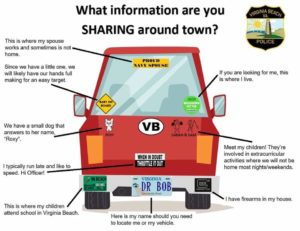
The Benefits of Living Gray – Part Two: At Home
By TorchStone VP, Scott Stewart
In the first part of this series, I discussed how traveling gray is a key strategy for those seeking to avoid being targeted by criminals, terrorists, and hostile security services while traveling. I defined being gray as fitting into the environment so that an observer does not see you as being out of place.
The goal of being gray is to present a neutral façade to outside observers so that you are perceived as neither a valuable nor a vulnerable target. Being gray is something anyone can do with a little research, thought, and effort.
While many people understand the benefits of being gray—especially when traveling to high threat locations—they tend to overlook the fact that being gray can also be beneficial at home. I would thus like to examine how to be gray at home in this second installment of the Living Gray series.
Understanding the Environment
One key to staying gray while traveling is understanding the environment—something that is also important at home. Sadly, many people put more effort into researching a place they will be visiting for a two-week vacation than they do for the environment where they live for the other 50 weeks of the year.
At home, people generally do not need to do the type of social and cultural research they do for overseas travel because they have a fairly sound understanding of their baseline home environment. However, people should make an effort to develop a detailed understanding of the crime environment in their home cities, as crime is not just something that happens abroad.
While Americans are concerned about being killed by terrorists or cartel gunmen while traveling overseas, statistics show that they may be more vulnerable at home. Only 151 American citizens were killed by criminals or terrorists abroad in 2019. There were 464 homicides in the city of Chicago alone that same year.
Despite a decline in violent crime in the U.S. over the past few decades, it remains a significant problem. Crime rates vary greatly across a city, and criminals will operate more brazenly in some sections of a city than others. Therefore, it is essential to understand where, when, and how criminals operate in the place you live.
Useful tools widely available on the Internet provide access to crime statistics and reports. Some of these websites are published by governments and local police departments; others are provided by real estate or alarm companies. And while the sites with this information may vary, simple searches of your location and “crime statistics” should yield relevant results.
Reading the local newspaper and following local police social media feeds will also be informative and useful. As neighborhoods change, so do crime trends. It is important to re-check these sites periodically to watch for new criminal trends and tactics.
Clothing and Accessories
In the current polarized U.S. environment, wearing clothing with political or offensive messages can draw hostile attention. We have seen people assaulted for wearing hats or clothing with a political message. Members of the Proud Boys and the Antifa movement are frequently involved in street fights and are not afraid to assault people they perceive as enemies. While one surely has the freedom to wear such items, one should also be aware that this freedom may have a price.
I would also apply this to political yard signs and bumper stickers because people’s homes and vehicles have been vandalized for displaying them. Is a public display of your political affiliation worth the potential risk it could create?
Like traveling abroad, avoid hot, attention-grabbing colors on the street at home. If you do decide to wear them, understand that they will draw more eyes than neutral colors. People who dress all in black or wear tactical clothing also draw attention to themselves.
Beyond clothing, what you carry with you on the street at home can also bring the wrong kind of attention. If you are wearing a watch or tennis bracelet worth several months of someone’s rent, people are sure to notice—and some of them are likely to have bad intent. But flashing cash and expensive accessories are not the only things that can draw untoward attention.
Firearms
Another accessory that can draw a lot of attention is a firearm. As uniformed law enforcement officers know, carrying a firearm can be dangerous. People will attack you specifically to steal your gun. In April 2015, for example, the two Boston Marathon bombers murdered a Massachusetts Institute of Technology police officer in an attempt to steal his pistol.
The threat of weapons theft requires people who are openly carrying a weapon to practice heightened situational awareness—there is a reason cops sit where they do in restaurants. This threat is also the reason police academies spend so much time training officers on weapons retention tactics.
Unfortunately, most open carry advocates do not have this type of training, making them vulnerable to having their weapons stolen. Over the past few months, I have encountered several people openly carrying firearms who were either not practicing an appropriate level of situational awareness or were using cheap holsters that would be easy to snatch a gun from—or both.
I do not want a potential assailant to know that I am armed to retain the element of tactical surprise until I decide to draw my firearm. I thus strongly recommend that if you are going to carry a firearm, you obtain a license to carry the firearm in a concealed manner—and then carry your firearm in a properly concealed manner. If you fail to conceal your firearm effectively, you are in effect carrying openly.
Vehicles
For this same reason, it is unwise to post gun bumper stickers or vanity license plates on your vehicle. These can make your vehicle a target for those wanting to steal guns. There is an array of other bumper stickers that can give away important information that thieves can use to target you, as the graphic below created by the Virginia Beach Police Department illustrates.
Vanity plates can also draw untoward attention. Not only because of the information they typically provide—such as your company name, stock ticker, or profession—but also because they are unique. There may be 10 black Mercedes S model cars in your city (or 50 if you live in a city like Austin or San Jose), but only one will have your vanity tag, making it stick out like a sore thumb from the flow of traffic. A vehicle with no bumper stickers and a plain license plate is the best way to stay gray while you drive.
Demeanor
Just as important as what you wear and carry is how you behave—your demeanor. Being loud, brash, or aggressive can draw hostile attention. Conversely, looking like you are lost or frightened can also draw a predator’s attention. Added to this is when and where you are displaying demeanor. Very little good will happen to people who are drunk on the street at 3:00 am, especially in the wrong part of town.
Situational Awareness
As I noted in the first installment of this series, situational awareness helps you be gray by behaving in accordance with the environment around you. It also allows you to see potential threats. Criminals are lazy and prefer easy prey. All things being equal, criminals and other hostile actors prefer to prey on people who are oblivious to their surroundings because it provides them the element of tactical surprise. They frequently avoid a target who has recognized them and instead focus their attention on a less aware target.
In the upcoming book, “Taking Mr. Exxon,” author Philip Jett chronicles the 1992 kidnapping of Exxon CEO Sidney Reso. Jett noted that Reso had received extensive security training prior to being posted abroad, but he did not believe it necessary to practice those same principles when he was home in New Jersey.
Reso’s negligence caused him to miss the lengthy and extensive preoperational surveillance his kidnappers conducted. He ultimately paid for that mistake with his life. Thus, situational awareness is absolutely something you must practice at home, not just when you are traveling overseas.
Finally, I want to stress that being gray is not something that only intelligence officers and special agents can do. Anyone can become gray if they desire to do so and are willing to make some effort—both while traveling and at home. In the third and final part of this series, I will discuss being gray online.

